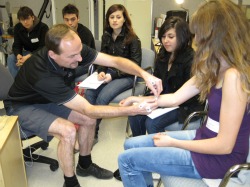
Dr. Collins placing electrodes on a student's arm to demonstrate how electrical stimulation works.
You can hear a pin drop in the human neurophysiology lab. A visiting high school science class is here to learn about the nervous system, and delve into some of the mysteries of the motor cortex.
All eyes are focused on an ordinary tin can, which is about to do something totally unexpected. Neuroscientist Dave Collins gently places the lab's star piece of equipment, the transcranial magnetic stimulator, over the can and cranks the juice.
When the tin can hits the roof and bounces off the ceiling with a show of force, Collins knows he has the students' attention; when he applies the stimulator to his head, they're riveted.
Of course, Collins' head isn't magnetic so he doesn't hit the ceiling, but it's the beginning of an engaging lesson about the motor cortex in the brain and how it controls the movement of the limbs. "We have this image of my brain on the screen," says Collins, "and I can move my head around and it shows different parts of my brain." The stimulator gives students a rare glimpse into the brain as it scans it in neat cross-sectional slices. And, says Collins, it gives students a good look at the map of the motor cortex as various parts of the brain are stimulated, causing reactions in hands, arms, legs, and clearly showing how the right side of the brain controls the left side of the body and vice versa.
Collins certainly isn't shy about being jerked about like puppet on a string as the grad students put him through his paces, stimulating his brain - and body - into action. "I wanted to be an actor," he says with a smile, "and this is now my stage!"
Collins' research focuses on understanding how the nervous system controls human movement, the role of the brain and spinal cord, and the reflex pathways that travel through the spinal cord, with the goal of developing ways to give people with spinal cord injuries some control of their movements.
Research aside, the tours are something Collins loves to do, welcoming a wide variety of student groups - and even kindergarten-aged kids - to visit and to learn what makes the nervous system tick.
Most recently a high school group came in as part of Discovery Day in Health Sciences, organized by The Canadian Hall of Medical Fame.
Aided by recent graduate Cam Mang, master's student Yoshi Okuma and doctoral student Austin Bergquist, Collins breaks the visiting students into small groups to demonstrate some of activities of the lab.
"We try to give them a feel for the types of questions we ask," says Collins. "I show the techniques that we use to study, and in doing that give them a feel for the questions that we ask. I don't start with the questions, because they're hard to grasp, but it's easy to put electrodes on a muscle and (see the electrical activity it creates when it contracts on the oscilloscope.")
There's a hum of conversation, heads bent low, and some laughter as students and their lab guides place electrodes on arms and legs and record the electrical activity as they contract their muscles, and stimulate nerves using electrical stimulation to get reflexes.
It's clear that Collins loves to have youngsters in the lab. "I like telling people about what we do. Also the lab is very visual and it's easy to describe and demonstrate what we do. You can see when we stimulate the brain and your arm twitches.
"I don't use this as a recruitment strategy," he says. "I would like it if some of the students got engaged in neuroscience and end up doing that somewhere. And if someone were to contact me and say, 'I came to a demonstration in your lab a couple of years ago, and I'd like to work with you, that would be fantastic. But I'm not expecting that."
While he thinks he may have to limit the number of school visits as word of the lab has spread through the school community and requests are mounting, for now the door is still open for students to take an uncommon journey into the core of the human body.
Visit the Human Neurophysiology lab at http://www.ualberta.ca/~dcollins/index.html